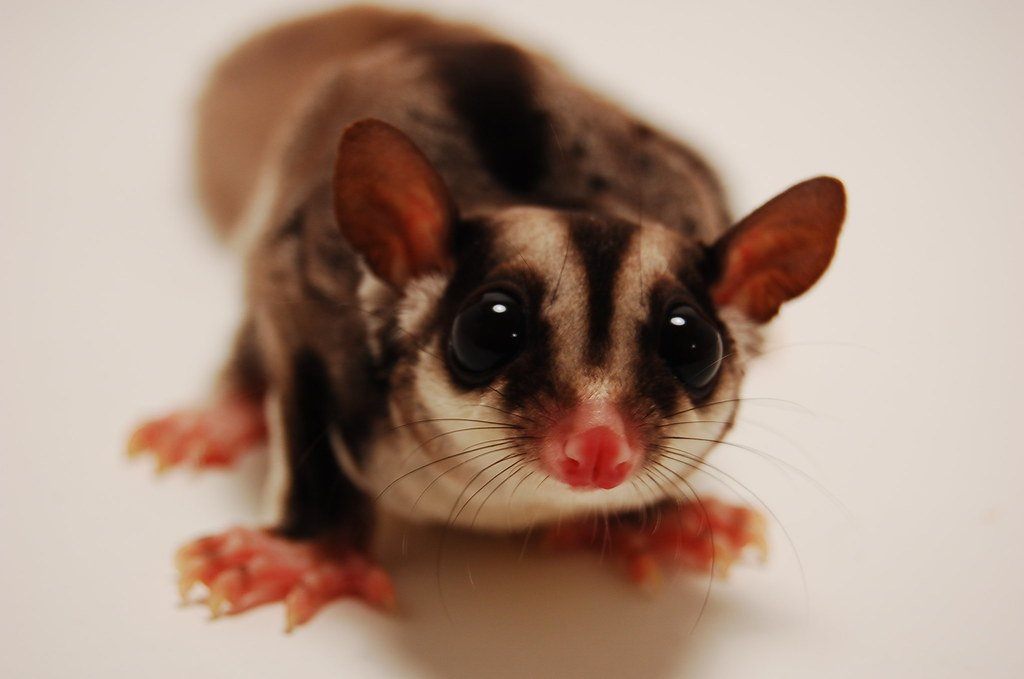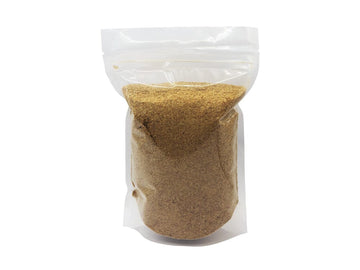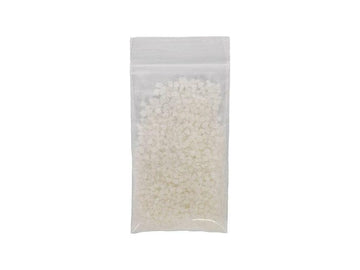The sugar glider (Petaurus breviceps) is a 5-6” long, arboreal, nocturnal mammal native to Australia and New Guinea. Although widespread and adaptable, their preferred habitat is always forest. These animals are also known as “sugar bears.”
Sugar gliders can be recognized by their pointed faces, large dark eyes, oblong ears, short but dense fur, large feet and claws, and a semi-prehensile tail roughly the same length as their body. But most notably, they have large flaps of skin on each side that allow them to glide from branch to branch like a flying squirrel. Coloring is typically medium gray with a pale underside. Their pattern features a dark dorsal stripe and a shorter stripe through each eye.
As exotic pets, sugar gliders are more demanding to house and care for compared to other popular small pet mammals such as rats, hamsters, gerbils, etc. So it’s important to know what you’re getting into, and whether they’re even legal where you live. When well cared for, sugar gliders can live up to 17 years.
Minimum cage size for sugar gliders
The absolute minimum enclosure size for a pair of sugar gliders is 24”L x 24”W x 36”H. Of course, larger is always better if you can manage it! Offering more space means you can provide a more varied landscape and more room for your pets to explore and exercise.
To prevent potential escape, the holes in the enclosure’s mesh/walls should be no larger than 1” x 0.5”. It is also best practice to cover 2 or 3 sides of the enclosure with opaque material to decrease stress for the occupants.
Cohabitation (housing multiple sugar gliders together) is required to keep this species happy, as they are extremely social. Most keepers maintain groups of two or three, which works well as long as there are not more males than females. The sugar gliders are most likely to get along when they’re siblings from the same litter. If you need to house strangers together, you will need to introduce them gradually to prevent conflict.
Do sugar gliders need special lighting?
Sugar gliders are nocturnal creatures, and prefer to avoid bright light. Furthermore, exposure to UV wavelengths can potentially damage their eyes. The light that you have in the room should be plenty for daytime lighting — just make sure to turn it off for nighttime!
Best temperature for sugar gliders
Although mammals are endotherms, which means they’re not as dependent on thermal gradients as ectotherms like reptiles, it’s still important to make sure your sugar gliders have access to the right temperatures to stay comfortable.
Air temperature in a sugar glider enclosure should stay between 75-88°F. Make sure you’re maintaining appropriate temperatures with a temperature gauge. If you don’t have a room in your home that is naturally this warm, you will need to provide artificial heating. A radiant heat panel controlled by an external thermostat works well for this purpose.
Best humidity levels for sugar gliders
Sugar gliders typically live in areas of high humidity between 70-90%, which is generally higher than the humidity in an average human home. So you will need to boost the humidity in your sugar gliders’ cage somehow. You can either add a humidifier to the room itself, or install a fogger in the enclosure, connected to a humidistat to prevent things from getting too wet.
To track humidity levels in your sugar glider cage, use a humidity gauge.
Best substrate for sugar gliders
While not absolutely required, providing a layer of bedding at the bottom of your sugar glider cage makes it easier to remove waste and keep the enclosure clean. We recommend the following substrates for sugar gliders:
- aspen shavings
- shredded paper
- carefresh
- fleece
- alfalfa pellets
Substrate should be around 2” deep and completely replaced or washed every week. Clean the enclosure with odorless products, as sugar gliders are very sensitive to chemicals!
Sugar gliders cannot be litterbox-trained.
How to decorate a sugar glider cage
A bare-bones enclosure makes for stressed sugar gliders, reducing their quality of life. Keep your pet entertained and engaged with its environment with the strategic use of décor items that encourage it to exercise natural behaviors!
Décor options for sugar gliders include:
- branches
- vines
- ropes
- hammocks
- ledges
- swings
- bird toys
- chew toys
What to feed to a sugar glider
Sugar gliders are omnivorous, which means that they need to eat both plants and meat/insects in order to get the right nutrition. Here are two methods of achieving this:
- 25% fruits and vegetables, and 75% commercial diet
- 25% fruits and vegetables, 25% protein, and 50% Leadbeater’s mix.
Food should be offered every day in correct proportions, but pay attention to your sugar gliders’ weight. If they seem skinny, offer more food. If they seem to be getting fat, reduce the amount of food and encourage them to exercise more.
Vegetables for sugar gliders: carrots, sweet potato, lettuce, collard greens, kale, cucumber, fresh eucalyptus leaves
Fruits for sugar gliders: apples, bananas, berries, melon, figs, grapes, mangoes, grapefruit, oranges, peaches, pineapple, kiwi, papaya
Protein options for sugar gliders: black soldier fly larvae, crickets, mealworms, earthworms, dubias, hard-boiled eggs
Commercial diets for sugar gliders: Mazuri Insectivore Diet, Exotic Nutrition’s Premium Diet, Nutrimax sugar glider diet, High Protein Wombaroo diet
Water
A side-mounted water bottle should be available at all times so your sugar gliders can stay well hydrated. Because sugar gliders are very sensitive to the chemicals in their environment, only use bottled water with your sugar gliders, never tap.
Supplements
While it’s best practice to offer a wide variety of foods to prevent nutritional gaps from developing in your sugar glider’s diet, you should still use an appropriate multivitamin supplement such as VitaMax or Glide-A-Mins, as well as a small amount of bee pollen power. Sprinkle the supplements over your sugar gliders’ salad every other day.
In addition to multivitamins, if you are not using commercial diet as a regular part of your sugar gliders’ nutrition, you will need to make your own “Leadbeater’s mix” to be offered daily. LafeberVet has a good recipe for this here.
How to handle your sugar glider
Sugar gliders are very social animals, and bond well with humans. That being said, here are some basic rules for creating a strong bond with your sugar gliders:
- Bring home your sugar gliders at 8-12 weeks old.
- Wait 2 days before attempting to handle them.
- Handle after your sugar gliders have woken up.
- Never move quickly or otherwise startle your sugar gliders.
- Be gentle and never grab or squeeze.
- If the sugar glider bites, don’t put it back immediately — this actually encourages undesirable behaviors.
- Be consistent and handle the sugar gliders for a couple of hours each night.
One fun way to bond with your sugar glider is by hand-feeding!
*This care sheet contains only very basic information. Although it’s a good introduction, please further your research with high-quality sources. The more you know, the better you will be able to care for your pet!
"Sugar Glider" by GarrettTT is licensed under CC BY-SA 2.0











